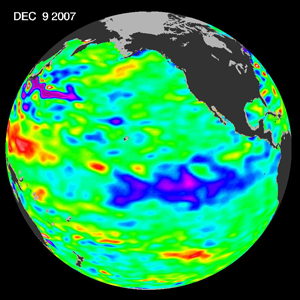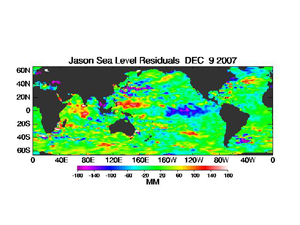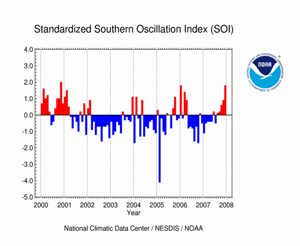LA NIÑA CONDITIONS INTENSIFY:
SOI REACHES ITS HIGHEST VALUE OF THE COLD EVENT
SOI REACHES ITS HIGHEST VALUE OF THE COLD EVENT
|
|
Sea-Surface Temperatures
(SSTs) and
Mixed-Layer Conditions: Equatorial Pacific Ocean surface and subsurface temperatures have been cooler-than-average over the past several months as a La Niña event developed and reached maturity. The cold anomalies persisted in December as the SSTs decreased across the central equatorial Pacific region. Water temperatures in the upper ocean also remained below normal, with an area of -2.0°C (-4.4°F) and cooler temperature anomalies in the mixed-layer in the central and eastern equatorial Pacific. Warmer-than-average upper ocean temperatures remained in the far western equatorial Pacific this month, primarily west of the Date Line. For the month, the SST anomaly in the Niño 3.4 Index region was -1.32°C (-2.38°F), which was a decrease of 0.05°C (0.09°F) compared to the November value. The SSTs in the Niño 4 Index region of the western equatorial Pacific were also below normal in December, with an anomaly of -0.73°C (-1.31°F) for the month (map of Niño regions). For the most recent global ocean surface temperatures, please see the loop of satellite-derived weekly SST anomalies for December 2007. The cooling of the SST anomalies in the Niño 3.4 index region over the past several months kept the 3-month running mean below -0.5°C (-0.9°F) in December, which is the Oceanic Niño Index (ONI) threshold for a cold event (NOTE: For NOAA's official ENSO classification scheme, please see NOAA's El Niño/La Niña Index Definition). The NOAA Climate Prediction Center's most recent ENSO Diagnostic Discussion indicated that ENSO remained in a moderate cold phase (La Niña), while the latest ENSO Wrap-Up from the Australian Bureau of Meteorology (BoM) concurred that La Niña conditions had intensified in the equatorial Pacific basin during December. Both CPC and the BoM have indicated that the La Niña will persist over the next several months, into the Boreal spring. |
| Equatorial Zonal
Winds (U-Component Winds) and Sea-Level Topography: The easterly Trade winds were stronger-than-normal across the western part of the equatorial Pacific during December. The above normal easterly winds along the equatorial zone increased upwelling of colder water in the mixed-layer, which intensified the below normal SST anomalies. The above normal easterly winds along the equatorial zone were especially evident in the western Pacific region, where monthly anomalies reached over 4 m/s (9 mph), while in the eastern equatorial Pacific the Trade winds were near-normal. Significant week-to-week variability in the near-surface winds has been observed along the equatorial region of the Pacific, as shown in the animation of December zonal winds. Stronger-than-normal easterly winds occurred across the far western Pacific region in mid- to late-December. Pacific sea levels measured by the NASA/JPL Jason-1 satellite remained significantly below average across the equatorial Pacific in December. The most recent satellite overpass measured a broad area of negative sea level anomalies in the central and eastern equatorial Pacific, which reflect the cooler-than-normal ocean surface and mixed-layer temperatures along the equator (see the 9 December 2007 Pacific sea level anomalies). |
|
|
Outgoing
Longwave Radiation (OLR): The map to the left shows the spatial pattern of global OLR (in W m-2) measured by satellite during December. An area of positive OLR anomalies was observed in the western Pacific along the equator, which extended eastward into the central Pacific along the Inter-Tropical Convergence Zone (ITCZ). Positive OLR anomalies were also observed over the past 3 months (October-December), with a broad area of suppressed tropical convection in the equatorial zone from the western Pacific to the South American coast. The persistence of positive OLR anomalies in the equatorial Pacific region is a typical atmospheric signal associated with La Niña conditions, and a reduction of deep tropical convection due to cooler SSTs in this region. The monthly OLR index increased signficantly in December, reaching a value of +2.2 W m-2 (averaged across an area in the western Pacific near the Date Line between 160° E and 160° W); an increase of 1.4 from the November value. This brought the OLR index to its highest value of the cold event, and was the tenth consecutive month with a positive OLR index value. Note: high frequency variability in OLR is typically associated with the Madden-Julian Oscillation (MJO), which is an intra-seasonal oscillation in convective activity that propagates west to east in the near-equatorial region from the Indian Ocean into the Pacific Ocean approximately every 30-60 days. The latest MJO activity can be seen in CPC's graphs of Daily MJO Indices. |
| Southern
Oscillation Index (SOI): The standardized value of the SOI was +1.8 in December, which was the highest SOI of the 2007/2008 La Niña so far. Overall, December was the fifth consecutive month with a positive index value [consistently positive (negative) values of the SOI are typical of La Niña (El Niño) conditions]. Therefore, the persistence of positive monthly SOI values over the past several months, as well as the increase in the SOI in December, indicates that the La Niña has entered its mature phase across the equatorial Pacific basin. |
Additional Links
- ENSO Monitoring
- NOAA El Niño / La Niña Index Definition
- NOAA's Pacific Marine Environmental Laboratory (PMEL):
- NOAA's Climate Prediction Center (CPC):
- NOAA's Physical Science Laboratory
- NASA/JPL Ocean Surface Topography from Space
- Australian Bureau of Meteorology (BoM) Climate Driver Update
- IRI - International Research Institute
 NOAA's National Centers for Environmental Information
NOAA's National Centers for Environmental Information







 Larger image of
December OLR Anomalies
Larger image of
December OLR Anomalies Larger image
of September-December OLR Anomalies
Larger image
of September-December OLR Anomalies Larger image of
December OLR Index
Larger image of
December OLR Index